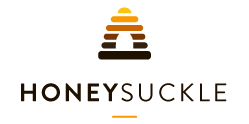The story of the Honeysuckle honey bees
Between the Overberg Mountains, not far from the sea, home to the Fynbos floral kingdom, Honeysuckle bees create magic every day. They collect nectar from the wild flowers far and wide along the country side. Using their long straw like tongues, nectar is drawn from the flowers. Our Honeysuckle honey bees visit around two million flowers to produce a single 500g jar of honey. Now that is nature’s gold!
In any one of the Honeysuckle hives, there are three types of bees, a single female queen bee, a number of male drone bees and on average around 40 000 female worker bees. After the nectar is brought in by the worker bees they transform the nectar to the perfect consistency and quality before storing it in the honeycomb cells. Then over time the honey is ripened by fanning their wings causing drafts over the honeycombs. These drafts in turn allow the water in the honey to evaporate to just the right level, leaving the honey ready for harvesting.
Here in the Overberg we harvest all kinds of honey throughout the year. In the summer we start with Wild Flower and Bluegum. In the colder months we have Fynbos and Canola, leading into pollination season, when we move our hives into the Blueberry and Apple Orchards. With a little Strandveld Honey harvested in between.
The Queen Bee is a formidable lady. She possesses the pheromone that basically lets all the other bees know what is needed and happening around her hive. She mates only once in her lifetime and lays about 1500 eggs per day! That is what I call commitment.
The Drone Bees are the only male bees in a hive and they can mainly be seen in the spring and summer times when the bee swarms tend to swarm off to establish new colonies. Their function in the hive is to mate with the Queen Bee.
But let’s just get back to the 40 000 worker bees for a moment. These ladies know how to get their hands dirty. Not only do they feed and tend to the eggs and larvae, they collect nectar, pollen and water for the hive, make wax, honey and propolis, clean the hive, feed the queen, regulate the temperature in the hive and even protect the hive. All in various stages of their lives which is only 35-45 days long.
And so we all have our role to play in bringing you the best quality products nature has to offer.
